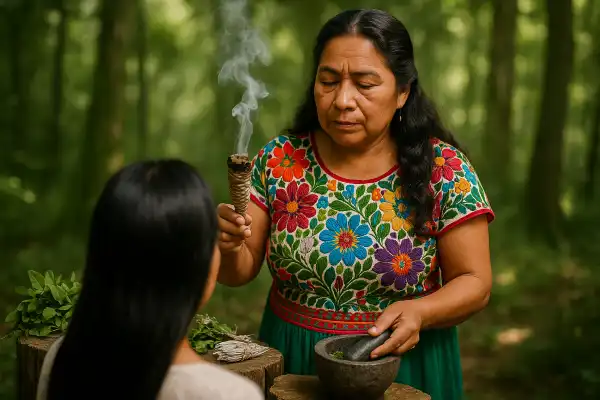How does curanderismo work? This question arises when people seek healing that addresses not just physical symptoms, but the deeper roots of imbalance that affect body, mind, and spirit. In our modern world, many feel disconnected from holistic approaches that honor the interconnectedness of all aspects of health.
María del Pilar Fernández, drawing from her lineage of curanderas in Oaxaca, believes that understanding curanderismo’s mechanisms can bridge ancient wisdom with contemporary wellness needs. Through her cultural anthropology studies and apprenticeships with traditional healers across Mexico, she recognizes that this sacred practice offers profound insights into how healing truly unfolds.
For broken hearts, you should read “Can curandera heal heartbroken people?”
How does curanderismo work?
Curanderismo works as a holistic approach to wellness that operates on three interconnected levels: physical (body), mental/energetic (mind), and spiritual (spirit), addressing illness through the integration of herbs, prayer, ritual, and energy work to restore balance and harmony. This traditional medicine system views illness as arising from natural or supernatural forces, treating conditions through a blend of herbal remedies, spiritual cleansing, massage, and prayer while emphasizing the relationship between healer and patient.

The foundational principles of curanderismo
Curanderismo operates on eight philosophical premises regarding the roots of disease and healing: strong emotional states, being out of balance with one’s environment, supernatural influences, social disharmony, physical ailments, spiritual disconnection, family dynamics, and environmental factors. Unlike Western medicine’s compartmentalized approach, curanderismo recognizes that healing must address the whole person within their cultural and spiritual context.
The Spanish verb “curar” means to heal, making curanderismo literally a system of healing whose goal is creating balance between the patient and their environment to sustain health. This balance encompasses relationships with family, community, nature, and the divine realm.
The three realms of healing
Traditional curanderos work within three hierarchical realms to facilitate healing:
Physical realm (body): This involves the use of ritual objects, plática (heart-to-heart conversation), plants and herbs, song, and prayer. Physical treatments include demonstrations of empacho (intestinal blockage), manteadas (shawl alignments), ventosas (fire cupping), and sobadas (traditional massages). Herbal remedies are carefully selected based on both their medicinal properties and energetic qualities.
Mental/energetic realm (mind): This level focuses on mental concentration, visualization, and directing healing energy at the non-local level. Curanderos help patients process emotional trauma, redirect negative thought patterns, and cultivate mental clarity through guided conversations and energetic practices.
Spiritual realm (spirit): This involves prayer and meditation to communicate with spiritual beings such as angels, saints, animal protectors, and deities for guidance and spiritual healing power. Prayer forms the foundation of curanderismo, as curanderas believe their healing abilities are gifts from God.
Spiritual cleansing and energy work
Spiritual cleansing, known as limpias, involves using herbs, eggs, and other tools to remove negative energy and restore harmony by clearing energetic blockages. These ceremonies recognize that emotional trauma, negative experiences, and spiritual imbalances can manifest as physical illness.
Traditional healing practices include temazcals (Mexican sweat lodges), Día de los Muertos ceremonies for healing grief, and sonido y música terapia (healing with sound and music). Each ritual serves specific purposes: temazcals provide physical purification and spiritual rebirth, while sound therapy helps release trapped emotions and restore energetic flow.
The role of faith and intention
Curanderismo places strong emphasis on the power of faith and intention in healing, with curanderos working to help patients cultivate trust and belief in the healing process while encouraging them to tap into their own inner strength and resilience. The healing process is based on the patient’s faith, and religion plays an important role as all healing is believed to come through God.
This faith-based approach doesn’t require specific religious beliefs but rather openness to spiritual healing and recognition of forces beyond the material realm. The practice involves plática, described as a “heart-to-heart” conversation that gives patients opportunity to share their entire story without judgment, creating confianza—a profound form of trust.
Integration with conventional medicine
Rather than an either/or approach, modern curanderismo seeks to educate healthcare providers about Mexican Indigenous healing ways so conventional medicine practitioners may become attuned to cultural needs while including traditional healers as part of a multidisciplinary treatment team. Research indicates that traditional healing practices among Mexican and Mexican Americans may be as high as 50-75% in some parts of the United States.
Curanderismo’s effectiveness comes from addressing root causes rather than just symptoms, creating sacred healing spaces, honoring cultural identity, and providing community support. Research in Mexican communities has shown that curanderismo can be as effective, and sometimes more effective, than psychotherapy for various mental health issues including anxiety, depression, and PTSD.
The curandero’s calling and training
Curanderos don’t first study to become healers but come to their vocation through spiritual calling or family lineage, with God or a higher power believed to grant them divine knowledge and skills to practice healing. A person can receive a God-given gift or don to become a curandero, or the gift can be accomplished through apprenticeship.
This calling often involves personal experiences of illness, trauma, or spiritual crisis that develop the curandero’s capacity for compassion and understanding. The training combines formal apprenticeships with experienced healers, cultural immersion, and ongoing spiritual development throughout their practice.
Disclaimer
Please note that Maria is not a physician, psychologist, or nurse. These culture-specific spiritual healing services are not meant to replace medical or psychological diagnosis and treatment. It is recommended that you see a licensed physician or licensed health care professional for any physical or psychological ailment you may have.
Recently, María del Pilar worked with Esmeralda, a young mother who came seeking help for chronic stomach pain that doctors couldn’t fully explain. After extensive medical tests showed no clear physical cause, Esmeralda felt frustrated and dismissed by the healthcare system. During their plática, María learned that Esmeralda’s pain began shortly after her own mother’s sudden death two years earlier.
“The body holds our grief,” María explained gently, as she prepared herbs for a traditional stomach remedy—manzanilla and hierbabuena tea. But the real healing came through a limpia ceremony where María used fresh basil and rosemary to sweep away the stagnant energy of unprocessed sorrow. As Esmeralda wept openly for the first time since her loss, she felt the tight knots in her stomach begin to release.
María also taught Esmeralda breathing exercises while holding a smooth river stone, connecting her to the earth’s grounding energy. Three weeks later, Esmeralda returned with gratitude—not only had her stomach pain significantly diminished, but she felt reconnected to her mother’s memory in a peaceful way. This integration of herbal medicine, energetic cleansing, and emotional release exemplifies how curanderismo addresses the whole person, honoring both the body’s wisdom and the spirit’s need for healing.
